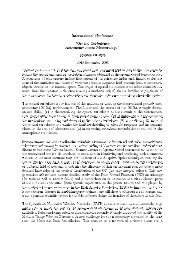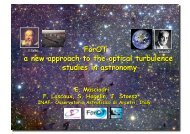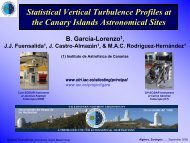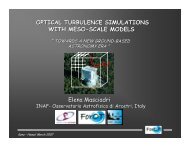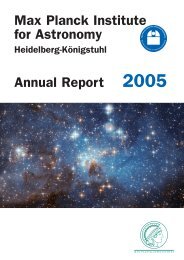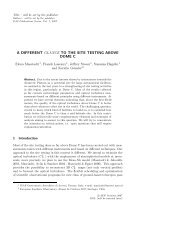Introduction to data assimilation in meteorology - ForOT Optical ...
Introduction to data assimilation in meteorology - ForOT Optical ...
Introduction to data assimilation in meteorology - ForOT Optical ...
Create successful ePaper yourself
Turn your PDF publications into a flip-book with our unique Google optimized e-Paper software.
<strong>Introduction</strong> <strong>to</strong> <strong>data</strong><br />
<strong>assimilation</strong> <strong>in</strong><br />
<strong>meteorology</strong><br />
Pierre Brousseau, Ludovic Auger<br />
ATMO 08,Alghero,<br />
15-18 september 2008
<strong>Introduction</strong><br />
Numerical weather-prediction systems provide <strong>in</strong>formative<br />
forecast of atmospheric variables.<br />
The accuracy of these forecasts depend on, among other<br />
th<strong>in</strong>gs, the <strong>in</strong>itial conditions used.<br />
Initial state at t 0<br />
state at t 0 +applet<br />
Model <strong>in</strong>tegration
<strong>Introduction</strong><br />
The ma<strong>in</strong> goal of a meteorological <strong>data</strong> <strong>assimilation</strong><br />
system is <strong>to</strong> produce an accurate image of the true<br />
state of the atmosphere at a given time, called<br />
analysis.<br />
This analysis could also be used as a comprehensive and<br />
self-consistent diagnostic of the atmosphere ( reanalysis).
Outl<strong>in</strong>es<br />
General ideas on <strong>data</strong> <strong>assimilation</strong><br />
Some k<strong>in</strong>ds of observation<br />
A new meso-scale <strong>data</strong> <strong>assimilation</strong> system<br />
Assimilation experiments
Assimilated <strong>in</strong>formation : observations<br />
Observation : a measurement of an atmospheric physical<br />
parameter.<br />
Exemple :<br />
Surface pressure measurements, 10 september 2008, 00 UTC
Assimilated <strong>in</strong>formation : background<br />
Problems :<br />
– Lack of observation <strong>in</strong> some part of the atmosphere.<br />
– Observation<br />
number<br />
smaller than the numerical state dimension (for AROME 10 4 VS 10 7 .( Need of an other<br />
<strong>in</strong>f<br />
ormation Background source : a previous x b forecast of the atmospheric state.<br />
Observations y o Analysis at t 0
General ideas : <strong>assimilation</strong> cycle<br />
Numerical model<br />
<strong>in</strong>tegration<br />
Background x b<br />
Analysis x a<br />
Observations y o<br />
6 hr forecast<br />
TIME<br />
6 hr <strong>assimilation</strong> w<strong>in</strong>dow
A simple case : estimation of the room temperature<br />
<strong>in</strong>formation : 2 measurements T 1 et T 2<br />
Best<br />
L<strong>in</strong>ear<br />
Unbiased<br />
Estimate<br />
M<strong>in</strong>imise the objective function<br />
8
Generalisation <strong>in</strong> <strong>meteorology</strong><br />
The Best L<strong>in</strong>ear Unbiased Estimate :<br />
x a = x b + applex<br />
= x b + (( BH T (HBH T +R) -1 (y o – H (x b<br />
, d : difference between<br />
optimal weight<strong>in</strong>g<br />
observations and<br />
background<br />
With :<br />
B and R<br />
resp<br />
ectively background errors and observations errors covariance matrices<br />
H : observation opera<strong>to</strong>r and H l<strong>in</strong>ear observation opera<strong>to</strong>r<br />
Variational formulation : m<strong>in</strong>imisation of the cost function<br />
,<br />
J(applex) = J b (applex) + J o (applex)<br />
(applex = applex T B -1 applex + (d-Happlex) T R -1 (d-H
Background error statistics<br />
Background-error statistics determ<strong>in</strong>e how observations modify the<br />
background <strong>to</strong> produce the analysis, filter<strong>in</strong>g and propagat<strong>in</strong>g<br />
<strong>in</strong>novations.<br />
B should conta<strong>in</strong> some <strong>in</strong>formation about the uncerta<strong>in</strong>ty of the guess,<br />
which depends on :<br />
– the model<br />
– the doma<strong>in</strong><br />
– the meteorological situation of the day (flow and <strong>in</strong>itial conditions).<br />
To determ<strong>in</strong>ate this uncerta<strong>in</strong>ty is a major problem <strong>in</strong> <strong>data</strong> <strong>assimilation</strong>
Outl<strong>in</strong>es<br />
General ideas on <strong>data</strong> <strong>assimilation</strong><br />
Some k<strong>in</strong>ds of observation<br />
A new meso-scale <strong>data</strong> <strong>assimilation</strong> system<br />
Assimilation experiments
Radiosonde observations<br />
Vertical profile of temperature, w<strong>in</strong>d and humidity :<br />
– very accurate<br />
– but only twice a day with an irregular spatial coverage
Satellite observations<br />
Instruments on :<br />
– geostationnary satellite.<br />
– polar satellite.<br />
Radiance measurements provid<strong>in</strong>g vertical profile of temperature and/<br />
or humidity (stra<strong>to</strong>sphere and high-troposphere).<br />
AMSU-A, 11 september 2008, 00 UTC (six hour <strong>assimilation</strong> w<strong>in</strong>dow)
Satellite observations<br />
Observations not always available on limited doma<strong>in</strong><br />
AMSUB <strong>in</strong>trument, 11 september 2008<br />
12 UTC : measurements<br />
from 2 satellites<br />
00 UTC : no measurement
Surface observations<br />
Surface pressure, 2m temperature and humidity and 10m w<strong>in</strong>d<br />
Very usefull <strong>to</strong> provide <strong>in</strong>formation on the low atmospheric layers<br />
10 september 2008, 00 UTC
Radar observations<br />
Doppler-w<strong>in</strong>d and reflectivity observations<br />
10 september 2008, 00 UTC
Different k<strong>in</strong>ds of observation<br />
Lots of observations which differ <strong>in</strong> :<br />
– Measured parameter<br />
– spatial and temporal coverage<br />
– resolution<br />
Observations <strong>in</strong>formative for<br />
– large-scale model : ex : AMSU-A (Atmospheric sounder) : resolution<br />
of 48 km.<br />
– Meso-scale model : ex : Doppler-w<strong>in</strong>d measurement
Outl<strong>in</strong>es<br />
General ideas on <strong>data</strong> <strong>assimilation</strong><br />
Different k<strong>in</strong>ds of observation<br />
A new meso-scale <strong>data</strong> <strong>assimilation</strong> system<br />
Assimilation experiments
The AROME project<br />
AROME model will complete the french NWP system <strong>in</strong> 2008 :<br />
– ARPEGE : global model (15 km over Europe)<br />
– ALADIN-France : regional model (10km)<br />
– AROME : mesoscale model (2.5km)<br />
<br />
Aim : <strong>to</strong> improve local meteorological forecasts of potentially dangerous<br />
convective events (s<strong>to</strong>rms, unexpected floods, w<strong>in</strong>d bursts...) and lower<br />
tropospheric phenomena (w<strong>in</strong>d, temperature, turbulence, visibility...).<br />
ARPEGE stretched grid<br />
and ALADIN-FRANCE doma<strong>in</strong><br />
AROME France doma<strong>in</strong>
Initial and lateral boundary conditions<br />
Lateral boundary<br />
conditions for Limited<br />
Area Model provided<br />
dur<strong>in</strong>g the forecast by :<br />
– a global model<br />
– a larger LAM<br />
Initial conditions could be<br />
provided by :<br />
– a larger model (dynamical<br />
adaptation)<br />
– A local <strong>data</strong> <strong>assimilation</strong><br />
system.<br />
Local <strong>data</strong> <strong>assimilation</strong><br />
systems for ALADIN and<br />
AROME
AROME <strong>data</strong> <strong>assimilation</strong> system<br />
Use a variational <strong>assimilation</strong> scheme<br />
2 w<strong>in</strong>d components, temperature, specific humidity and surface<br />
pressure are analysed at the model resolution (2.5 km).<br />
Use of a Rapid Update Cycle<br />
Forecasts <strong>in</strong>itialized with more recent observations will be<br />
more accurate<br />
Us<strong>in</strong>g high temporal and spatial frequency observations<br />
(RADAR measurements for example) <strong>to</strong> the best possible<br />
advantage
Objective scores : analysis compared <strong>to</strong> radiosonde at<br />
00 UTC<br />
<br />
Analysis from the AROME RUC compared <strong>to</strong> ALADIN analysis show an<br />
important reduction of Root Mean Square Error and Bias for all<br />
parameters all over the troposphere except for the humidity field around<br />
200 hPa<br />
---------- Bias --x---x-- rmse<br />
Temperature w<strong>in</strong>d specific humidity
Objective scores : forecast compared <strong>to</strong> surface<br />
observations<br />
Improvement <strong>in</strong> the first hours of the forecast<br />
Surface pressure<br />
<strong>assimilation</strong><br />
Dynamical<br />
adaptation<br />
2m temperature<br />
---------- Bias<br />
--x---x-- rms
First results<br />
objective scores show that the general benefit of the AROME<br />
analysis appears dur<strong>in</strong>g the first 12-h forecast ranges, then<br />
lateral conditions mostly take over the model solution.<br />
Subjective evaluation confirms many forecast improvement dur<strong>in</strong>g<br />
the first 12-h forecast ranges. In some particular cases, this<br />
benefit can also be observed after this range.
Outl<strong>in</strong>es<br />
General ideas on <strong>data</strong> <strong>assimilation</strong><br />
Different k<strong>in</strong>ds of observation<br />
A new meso-scale <strong>data</strong> <strong>assimilation</strong> system<br />
Assimilation experiments
Precipitat<strong>in</strong>g event, 5 oc<strong>to</strong>ber 2007<br />
RADAR<br />
MEASUREMENT<br />
AROME with<br />
<strong>assimilation</strong><br />
24-h cumulative<br />
ra<strong>in</strong>falls<br />
Better location<br />
of the maximum<br />
of precipitation<br />
AROME <strong>in</strong> dynamical<br />
adaptation<br />
ALADIN<br />
80 mm
Fog event, 7 february 2008<br />
<br />
<br />
AROME low cloud cover at 9-h UTC<br />
Fog is not simulated <strong>in</strong> sp<strong>in</strong>-up mode<br />
<strong>assimilation</strong><br />
Dynamical<br />
adaptation
28<br />
Experiment <strong>in</strong> order <strong>to</strong> evaluate<br />
the <strong>in</strong>fluence of additional<br />
Ground-based GPS observations <strong>in</strong><br />
AROME <strong>data</strong> <strong>assimilation</strong> system.<br />
Use of 194 stations (blue star) +<br />
84 additional stations (green<br />
circle).<br />
Give <strong>in</strong>formation on <strong>in</strong>tegrated<br />
humidity profile
Cumulative ra<strong>in</strong>fall, 18 July 2007 03-15 UTC<br />
29<br />
194 stations<br />
Ra<strong>in</strong>gauges<br />
measurements<br />
194 + 84<br />
stations
Conclusion on <strong>data</strong> <strong>assimilation</strong><br />
Data <strong>assimilation</strong> provide an accurate image of the true state of<br />
the atmosphere at a given time <strong>in</strong> order <strong>to</strong> <strong>in</strong>itialize numerical<br />
weather forecast us<strong>in</strong>g :<br />
– Observations<br />
– A previous forecast of the state of the atmosphere<br />
Observations used are various and numerous and provide large and<br />
small scale <strong>in</strong>formation.<br />
The use of a meso-scale <strong>data</strong> <strong>assimilation</strong> system improve Limited<br />
Area Model forecast accuracy up <strong>to</strong> 18 hours.<br />
This system has been tested for one year and will be put <strong>in</strong><strong>to</strong><br />
operation next month
Thank you for your<br />
attention…



